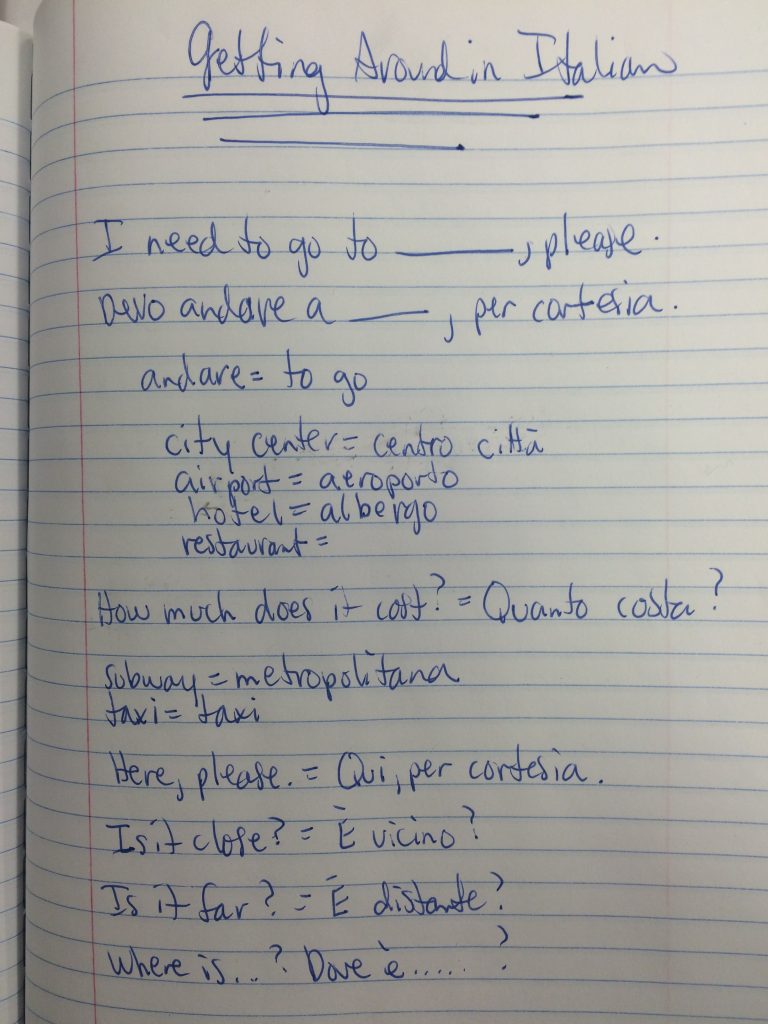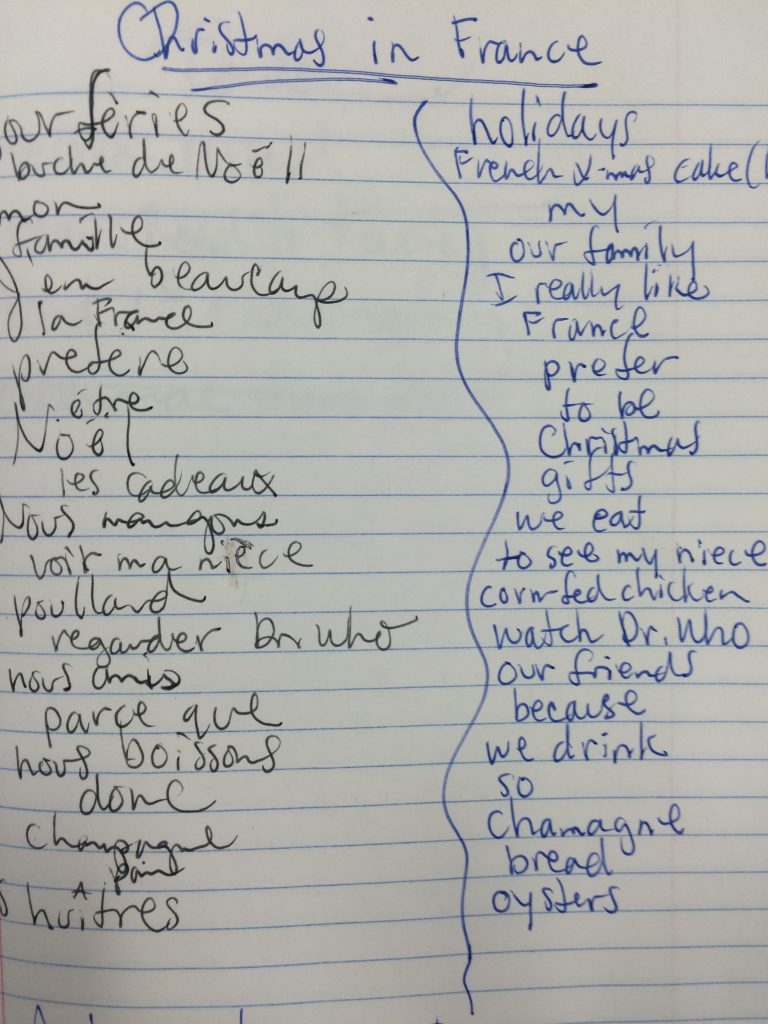
Free Language Learning with Notebooks
Check out these completely free ways to learn a language.
I am a huge proponent of task-based language learning. While grammar, structures and vocabulary are important, you can’t communicate immediately if you set the focus there. When learning is task-based, you are learning how to communicate in real situations in the target language. This is valuable as it will serve you immediately. You will learn to focus on learning what you need to fulfill a task and not worry about what you don’t need. Eventually, the tasks start overlapping, and you will find yourself creating your own messages from the language you learned to complete each task. Grammar and vocabulary will be in context as well, making that easier to learn than working the other way around.
Free language learning activity #1: Task Notebooks
Utilize copying just like you did when you learned how to read and write in your own language to learn a new language.
Here is an example of a beginning task notebook in Korean. The task is basic ordering at a restaurant:

The next example is a little more involved. The task is getting around in Italian:

You can use these to map out anything you want to learn. You can also follow it up with vocabulary columns to learn the new task so deeply you won’t forget it.
Free language learning activity #2: Vocab Columns
Write down the words and phrases you want to learn. Be sure to do this in columns, and not rows. The example below is one I did in French for family vocabulary:

Fill in the columns. Each time you are recognizing the new language (easier first) and learning the words in the target language (more challenging). You will find the gaps in your knowledge as you do this. Review what you couldn’t remember and then move on in the columns. Have it checked by a native. This was from an earlier stage of my French. I had mine checked by a native French speaker and learned that I had spelled the word for niece incorrectly. I fixed it in the next column.
Do until you have mastered the set. It really works!
Free language learning activity #3: Fluency journals
Do you want an amazing way to build fluency in any language, at any level? If so, you should definitely try fluency journals if you’ve not done so thus far. They work great for independent language learners as well as structured classes.
It doesn’t matter what the level is, what the topic is, you have a task. A task that you want to learn, or that you want your students to learn. Something that you want people to be able to do in the target language. Let me give you some concrete examples.
Let’s pretend that I need to complete the task of returning something to a store. Or I want to learn how to talk about my family. What’s cool about a fluency journal is you can set a timer–use your iPhone or something like online stopwatch. With groups of people, particularly younger kids, I like to use big sand timers because that way they can see how long they have.
You have the topic (whether you’re giving the topic to your students or you’re doing the topic yourself) you’re going to set the timer and tell yourself (or whoever) to write as much as they can about the task in as much detail as possible. For a beginner of French, I might say, talk about your family. During that time, the person can just write as much as they can about their family. Maybe they want to talk about who is in their family, where their family is, what the different people in their family are like, or what the relationships are like. Maybe if you’re a little bit more advanced, you might use this as an opportunity to compare and contrast family structures in the target language and your culture. What’s the same, what’s different? What would it have been like to grow up in a French family?
Whatever that topic is, you’re going to time it. If we go down to that novice level (beginning words and phrases) what that might look like in your class? They might be writing some words and phrases and trying to make sentences. At the advanced level, you might be very quickly writing long paragraphs or entire pages of text. But the whole point is to practice fluency on a certain topic.
One thing that I really like about this activity is that it has some huge benefits. When you sit down to write, I wouldn’t allow myself any vocabulary, any dictionaries or any help. For a really novice learner, you might want to go ahead and map out a couple of those things beforehand. Perhaps jot down some vocabulary, or review vocabulary to talk about family, or about adjectives to describe people.
What’s really great about this is there’s no pressure- the kind you might get in a conversation where you feel a bit stressed trying to create language and express an idea in a conversation. It’s fantastic. You can just sit down on your own and practice fluency. What would you say if somebody asked you about your family? Or any of those different topics that we talked about? There’s no pressure. What’s great is if you don’t allow yourself any dictionaries or any help or glossaries, you’re going to find you are filling in your gaps. You’re going to find out what you don’t know how to say, and that’s going to prompt you to go back to your notes, go back to your teacher, go back to your dictionary, or your students to you if you’re a teacher. And you’re going to find out what you don’t know. Then you’re going to be able to dig back and find those things.
One way that I love to use this is in my classes, of course, because it’s a fantastic fluency builder. You get to see really naturally what can they do. I really like to make all their corrections and give them really detailed feedback. As a learner, I like to do them and hand them to a native speaker and get the corrections. Then I study the corrections and know exactly what I could have done a little bit differently.
Free language learning activity #4: Letters
Letters. A great interactive way to learn to you use a vocabulary notebook. When I was a language student (way before email) pen pals were a fairly regular activity. They look a little bit different now, and there are a whole lot more sophisticated, being able to do these by email.
Google your target language and pen pals. There’s people all over the world that want to learn English and will be happy to correspond with you. It’s a great way to practice your language skills and get input through letters.
During one of the most difficult parts of my life, I had an opportunity to go see Elizabeth Gilbert and participate in her Big Magic workshop. I always find listening to her uplifting because she’s funny, and she’s wise, in my opinion.
One of the activities that you do throughout the day is write letters to yourself. You then share them with strangers. It sounds absolutely terrifying. In fact, when you go to the workshop, she makes you sit with people that you’ve never met.
You write these letters to these different parts of yourself. Then, you share them. Some people were brave enough to stand up in front of thousands of people and share them. It’s sort of like that stranger on an airplane. Sometimes people can talk about something freely knowing they’ll likely never see the person again, and it can be very cathartic. It really is the same idea. It forces you to put down on paper, release, and uncover some important emotions.
For an advanced language activity, I don’t think this could be better designed than what she’s done. Write letters to yourself. Use whatever you need to find the language that you need to put in your journal and express yourself.
Are you looking for some more fun ways to use vocabulary notebooks? Check out this post on doodles and sketches. Want 400 plus writing prompts? Check out the language learning workbook here.
Want to master a language in the next year? https://real-life-language.teachable.com/p/the-5-week-linguist